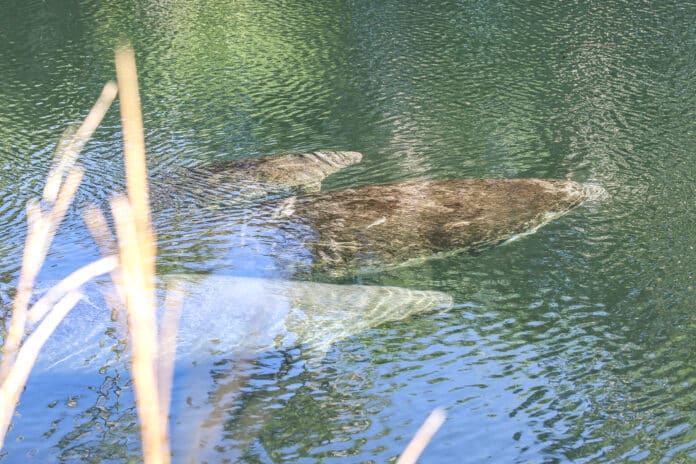Over the last few weeks, the Mud River, a popular attraction for locals and tourists alike, has seen its fair share of death – not of any people, but manatees. Since the beginning of the calendar year, the carcasses of five “sea cows” have been found in the waterway located in Hernando County. If the cause is not determined and accounted for, that number could continue to rise. This has not gone under the radar, though, as bodies like the University of Florida (UF) and the Florida Fish and Wildlife Conservation Commission (FWC) are looking into the issue.
When reached for comment, Information Specialist Jonathan Veach stated that the FWC has been documenting the increase of adult manatee carcasses in the river in a release on Tuesday. “Preliminary investigations attribute these deaths to an acute lethal gut shock from a sudden dietary change, causing a significant disruption within the manatees’ digestive system […] The FWC has an unwavering commitment to manatee health and safety and this event underscores the need to continue collaborative efforts with our conservation partners and members of the public during this investigation,” said Veach. In an email from Marine Agent Brittany Hall-Scharf, UF/IFAS provided a breakdown of events and details surrounding the deaths of the sweet creatures: Five adult manatee carcasses were removed from the Mud River during the opening month-plus of 2024. This was as of February 9.
![Sea Grant Agent Brittany Hall- Scharf and Stacey Strickland at Linda Pedersen Park, testing out their drone equipment from the observation tower. [Credit: Alice Mary Herden]](https://www.hernandosun.com/wp-content/uploads/2024/02/Hernando-Manatees-05-1024x683.jpg)
There has been confusion on whether the number was five or six due to one of the deceased manatees being pregnant, but the mother and unborn calf are being counted as one.
A single manatee was found during the week of January 29. The final three were found “last week” as of Hall-Scharf’s February 15 email. Once recovered, the five bodies were transported to the FWC’s Marine Mammal Pathology laboratory and necropsied.
The preliminary diagnosis is an “acute lethal gut shock.” The marine agent states that this occurrence is similar to a fatal natural disease among manatees that has been documented in places across the state, such as the Indian River Lagoon. The abrupt dietary change “from seagrass to macroalgae causes severe disruption in the gut flora,” she noted.
The commission is currently testing samples to determine whether this diagnosis is correct or whether other factors like contaminants could have come into play. The FWC estimates that the testing will take a minimum of one month to parse out the manatees’ cause of death. The organization will also continue working on identifying the algae that was found in the manatees’ guts.
Hall-Scharf has provided local volunteers with details “on how to monitor respiration rates of manatees they believe are in distress.” This way, those on hand can relay the particulars to FWC dispatchers and biologists when they call in to report manatees that are struggling. A decision can then be made on whether a rescue is necessary.
These groups were not the only ones to take note of this serious issue. At the most recent Board of County Commissioners meeting on February 13, nearly every speaker discussed the death of the manatees during the citizens’ comments segment. Lynne Herrick is one such member of the community who is invested in ensuring the health and safety of the local rivers and the wildlife in them. She is so concerned about the recent developments that she stopped by the meeting after dropping her husband off at the hospital for a heart catheterization. Her passion was on full display as she brought photographs that she had personally taken of the dead manatees, and she spoke of two threats facing the creatures: collisions and diminishing seagrass.
![Manatees at Linda Pedersen Park, Feb. 2020. [Courtesy: Brittany Hall-Scharf]](https://www.hernandosun.com/wp-content/uploads/2024/02/Hernando-Manatees-01-1024x498.jpg)
“Seagrass needs sun and shallow water to grow,” said Herrick. As manatees feed on seagrass, “manatees spend much of their time in shallow water. This leaves them little time to dive away from oncoming boats, which can lead to deadly collisions.” She pointed out that “a major threat to seagrass is propeller scarring.” This occurs when “boat propellers in shallow water impact roots, stems, leaves of seagrasses, producing long narrow furrows devoid of vegetation.” These man-made riverbed scars can take years to heal. This leads to difficulty for the manatees in finding seagrass, which, in turn, can lead to them searching out alternate food sources such as macroalgae.
Long-time river user and Hernando County resident Kay Garcia does not want people to stop “enjoying the river.” She simply wants them “to respect the river.” This extends to rental boats. Garcia seconded Herrick’s comments regarding manatees and potentially fatal collisions with boats. The aquatic vessels are so wide in comparison to the Mud River that manatees may not have room to swim when those vehicles pass by. As a result, she noted, tragically, that “every manatee I see has a boat scrape” on it. “This is not normal. There is something going on with the river and we really need people to pay attention to what is going on out there,” said Garcia.
If any citizens find sick, injured, or dead manatees, Veach urges that they contact the FWC’s Wildlife Alert Hotline at 1-888-404-FWCC (3922).
![Drone photo of manatees located in the Mud River, Feb. 2020. [Courtesy: Brittany Hall-Scharf]](https://www.hernandosun.com/wp-content/uploads/2024/02/Hernando-Manatees-08_-Mud-River-1024x576.jpg)

